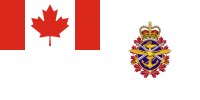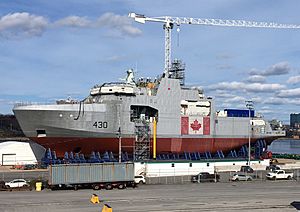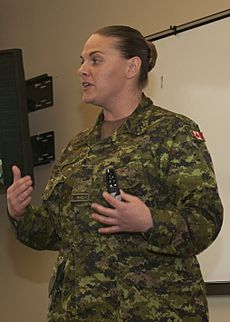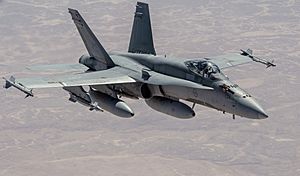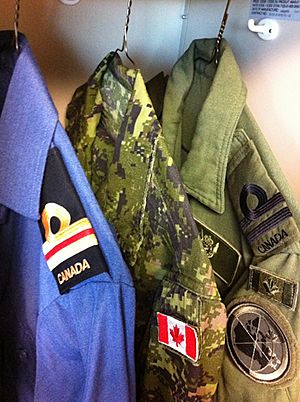Canadian Armed Forces facts for kids
The Canadian Armed Forces (CAF; French: Forces armées canadiennes, FAC) are Canada's military forces. They bring together the sea, land, and air elements, which are known as the Royal Canadian Navy, Canadian Army, and Royal Canadian Air Force. There's also the Canadian Special Operations Forces Command.
People who join the CAF can be part of the Regular Force (full-time) or the Reserve Force (part-time). The Reserve Force has different groups like the Primary Reserve, Supplementary Reserve, Cadet Organizations Administration and Training Service, and the Canadian Rangers. The Canadian Armed Forces are separate from the Department of National Defence, which handles defence policy and supports the forces.
The Canadian Armed Forces is a professional group made up of volunteers. It has about 68,000 full-time members and 27,000 part-time members. Around 3,000 members are currently serving overseas in various missions. For example, they are part of Operation Snowgoose in Cyprus, Operation Unifier helping Ukraine, Operation Caribbe in the Caribbean Sea, and Operation Impact against ISIL.
The Commander-in-Chief of the Canadian Armed Forces is Canada's monarch. The monarch is represented by the Governor General, Mary Simon. The main military leader is the Chief of the Defence Staff, currently General Wayne Eyre. This person works with the Minister of National Defence, Bill Blair, to manage the forces. In 2021, Canada spent about $26.4 billion on its military.
Quick facts for kids Canadian Armed ForcesForces armées canadiennes |
|
|---|---|
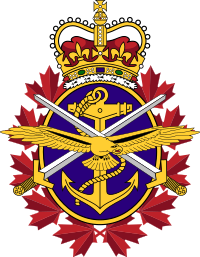 Badge of the Canadian Armed Forces |
|
| Current form | 1 February 1968 |
| Parts | |
| Headquarters | National Defence Headquarters, Ottawa, Ontario |
| Leadership | |
| Commander-in-Chief | Charles III, King of Canada, represented by Mary Simon, Governor General of Canada |
| Minister of National Defence | Bill Blair |
| Serving soldiers | |
| Military age | 16–60 years old |
| Conscription | No |
| Active employees/soldiers | approx. 68,000 (2021) |
| Reserve personnel | approx. 27,000 (2021) |
| Deployed personnel | approx. 3000 |
| Expenditures | |
| Budget | US$26.4 billion (2021) (ranked 13th) |
| Percent of GDP | 1.4% (2020) |
| Industry | |
| Suppliers from inland |
List
L-3 Communications MAS |
| See also | |
| History | Military history of Canada
List of engagements
Fenian Raids |
| Ranks | Canadian Armed Forces ranks and insignia |
|
|
|
Contents
History of Canada's Military
Canada's military history is long and interesting. The Canadian Armed Forces have grown a lot over the years.
How the Forces Started
Before Canada became a country in 1867, people in the colonies served in local groups called militias. These groups helped defend their lands from attacks by other European powers and Indigenous peoples. They also fought against American forces in wars like the War of 1812. Some Canadian Army units today can trace their history back to these early militia groups.
For a long time, the British Crown was in charge of Canada's military. British soldiers and sailors were stationed in Canada until 1906. After that, Canada formed its own navy, the Royal Canadian Navy, and later its air force, the Royal Canadian Air Force. These forces were part of the Department of Militia and Defence.
Canadian soldiers first went overseas during the Second Boer War. They also played a big part in the First World War. Important battles for Canadians included the Second Battle of Ypres and the Battle of Vimy Ridge. Canada's military achievements in the First World War helped the country gain more independence from the United Kingdom in 1931. In 1940, the Canadian militia officially became the Canadian Army.
Canada joined the Second World War in September 1939. Canadian forces fought in major battles like the Battle of the Atlantic and the Battle of Hong Kong. They also took part in the Dieppe Raid and the invasions of Sicily and Italy. By the end of the war, Canada had the fourth-largest air force and fifth-largest navy in the world.
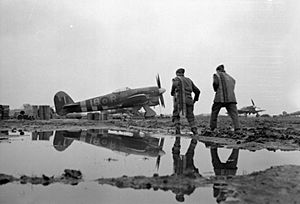
Since 1947, Canadian military units have been involved in over 200 operations around the world. They are known as world-class professionals. They have played key roles in NATO missions, like during the Korean War and the Gulf War. They have also been part of many United Nations Peacekeeping operations, including in Cyprus and Afghanistan.
Modern Canadian Armed Forces
The Canadian Armed Forces as we know them today were formed on February 1, 1968. This is when the Royal Canadian Navy, Canadian Army, and Royal Canadian Air Force merged into one unified structure. In 2011, the names of the three main branches went back to their historical names, but the unified structure stayed the same.
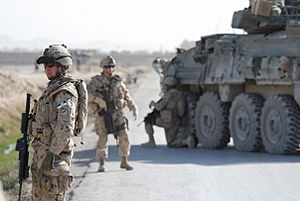
Since 1968, Canadian forces have served in NATO missions in Europe and in peacekeeping operations. They also took part in combat missions, like in Afghanistan until 2011.
The forces also help out in Canada during emergencies and natural disasters. For example, over 8,500 military members helped during the 1997 Red River flood in Manitoba. More than 16,000 troops were deployed after the North American ice storm of 1998. This was the largest deployment of Canadian troops for a natural disaster in Canada's history. They also helped fight forest fires in British Columbia in 2003.
Modernizing the Forces
The Canadian government is in charge of national defence. In 2008, the government started the "Canada First Defence Strategy" to modernize the forces. This included buying new equipment, improving training, and creating the Canadian Special Operations Regiment. More money was also put into finding new recruits.
New equipment bought includes tanks, artillery, and unmanned aircraft. They also got new transport aircraft like the C-130 Hercules and C-17 Globemaster III, and helicopters like the CH-47 Chinook. New ships are also being built for the navy.
Women in the Canadian Armed Forces
In the 1950s, women could join the CAF in roles like medicine and administration. In 1971, more opportunities opened up for women. They could become vehicle drivers, mechanics, air-traffic controllers, military police, and firefighters.
By 1989, almost all military jobs were open to women. This greatly increased the number of people who could join the forces. By 2000, women were even allowed to serve on submarines.
All equipment, like helmets and uniforms, is designed to fit both men and women comfortably and safely. Women's uniforms are similar to men's but are made to fit the female body.
How the Canadian Armed Forces are Organized
The Canadian Armed Forces are led by the Crown, which is Canada's monarch. The monarch's representative, the Governor General, acts as the commander-in-chief. All orders for troop movements or declarations of war are signed by the monarch or governor general. However, they usually follow the advice of the Prime Minister and the Minister of National Defence.
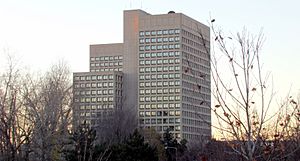
The Canadian Forces have about 95,000 members, including full-time and reserve personnel. They are organized into different ranks of officers and non-commissioned members. The Chief of the Defence Staff is the highest-ranking officer and leads the Armed Forces Council. This council includes leaders from the Navy, Army, Air Force, and other commands. The council usually works from the National Defence Headquarters in Ottawa.
The Canadian Forces operate from 27 bases across the country. New members get their basic training at the Canadian Forces Leadership and Recruit School in Saint-Jean-sur-Richelieu. Officers often get their training at the Royal Military College of Canada.
The Royal Canadian Navy (RCN) is led by the commander of the Royal Canadian Navy. It has 28 warships and submarines. These ships are based on the west coast at CFB Esquimalt and on the east coast at CFB Halifax. The RCN also has aircraft and supply ships. The Navy takes part in NATO exercises and sends ships around the world to support international missions.
Canadian Army
The Canadian Army is led by the commander of the Canadian Army. It is organized into four divisions: the 2nd Canadian Division, 3rd Canadian Division, 4th Canadian Division, and 5th Canadian Division.
The full-time part of the Army has three ready-to-deploy groups called brigade groups. These are located at CFB Edmonton, CFB Shilo, CFB Petawawa, CFB Gagetown, CFB Valcartier, and Quebec City. Each brigade group includes units for artillery, armoured vehicles, engineers, and infantry. They also have support units for logistics and communications.
The Army also has ten Reserve Force brigade groups across the country. Major training centres are located at CFB Gagetown, CFB Montreal, and CFB Wainwright.
Royal Canadian Air Force
The Royal Canadian Air Force (RCAF) is led by the commander of the Royal Canadian Air Force. The commander of 1 Canadian Air Division is in charge of all Air Force operations in Canada and worldwide. These operations are carried out through eleven wings across Canada. The commander of 2 Canadian Air Division handles training and support.
Major air bases are located in British Columbia, Alberta, Saskatchewan, Manitoba, Ontario, Quebec, Nova Scotia, and Newfoundland and Labrador. The RCAF also has forward operating locations in Canada's northern region. These locations can support fighter jet operations and are used for training and protecting Canada's Arctic.
Canadian Joint Operations Command
The Canadian Joint Operations Command (CJOC) was created in 2012. It combines the resources and responsibilities of three former commands. CJOC manages military operations both in Canada and overseas.
Canadian Special Operations Forces Command
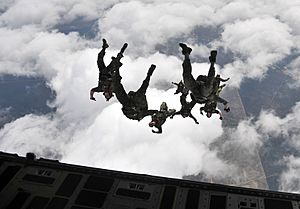
The Canadian Special Operations Forces Command (CANSOFCOM) is a special unit that can operate on its own. Its main job is to provide special operations forces (SOF) to support CJOC. This command includes Joint Task Force 2 (JTF2), the Canadian Joint Incident Response Unit (CJIRU), the Canadian Special Operations Regiment (CSOR), and the 427 Special Operations Aviation Squadron (SOAS).
Other Important Groups
- Information Management Group: This group is responsible for electronic warfare and protecting the Armed Forces' computer networks. They work to keep communications safe.
- Royal Canadian Medical Service: This group includes all medical staff who provide health services to CAF members.
- Royal Canadian Dental Corps: This group includes all dental staff who provide dental care to CAF members.
- Canadian Forces Health Services Group: This group brings together over 120 units that provide health services to the Canadian Armed Forces.
Canadian Armed Forces Reserve Force
The Canadian Armed Forces have about 50,000 reserve members. These individuals can be called upon during national emergencies. The Reserve Force includes:
- Primary Reserve: About 26,000 soldiers, sailors, and airmen who are trained like full-time members. They can be assigned to CAF operations.
- Supplementary Reserve: About 11,000 members who can be called upon if needed.
- Cadet Organizations Administration and Training Service (COATS): About 7,500 officers and non-commissioned members who train and supervise nearly 60,000 cadets aged 12 to 18.
- Canadian Rangers: About 5,000 members who patrol and watch over Canada's Arctic and other remote areas. They are important for protecting Canada's northern territory.
Defence Policy and Spending
Canada's defence policy has three main goals:
- Protecting Canada itself.
- Defending North America with the help of US forces.
- Helping with international security around the world.
During the Cold War, Canada's military focused on helping to protect Europe from the Soviet Union. Canadian ground and air forces were based in Europe for many years. Since the Cold War ended, the Canadian military has become more involved in international security operations, especially in Afghanistan from 2002 to 2014.
Canada's current defence strategy, called "Strong, Secure and Engaged" (SSE), was introduced in 2017. It promises more funding to support the military in its main tasks. The Canadian Armed Forces also help with "defence diplomacy." This means they build relationships with other countries' militaries through visits, training, and other activities.
The Canadian government is responsible for defence spending. In 2021, Canada spent about $24.3 billion on defence. In April 2022, the government announced it would increase defence spending by $8 billion over the next five years.
Ranks and Uniforms
Ranks in the CAF
The Canadian Armed Forces have a system of ranks and insignia for its members.
Uniforms of the CAF
Even though the Canadian Armed Forces is one single service, its members wear three different coloured uniforms:
- Navy members wear navy blue (which looks black).
- Army members wear rifle green.
- Air Force members wear light blue.
Members in operational jobs usually wear the uniform colour that matches their branch. Members in non-operational jobs wear a uniform based on their branch's history or their preference. So, you might see all three uniform colours in the same unit.
There are five main types of uniforms:
- Ceremonial dress: Worn for special events, with items like swords and medals.
- Mess dress: Worn for formal evening events.
- Service dress: Like a business suit, worn for daily duties or public events.
- Operational dress: Worn for everyday work on base or in the field.
- Occupational dress: Special uniforms for specific jobs, like medical staff or firefighters.
The most common everyday uniform is the operational dress. For winter, members can wear parkas, and a light jacket for cooler days.

Some units, like those in the Canadian Army and cadets at the Royal Military College, also wear full-dress uniforms. The Army's full-dress uniform usually includes a bright red jacket and dark blue trousers. Many regiments have their own unique full-dress uniforms.
The most common hats worn are the beret, wedge cap, and ballcap. The colour of the hat depends on the branch or mission. Naval personnel often wear service caps or ballcaps. Air Force personnel, especially officers, like the wedge cap. Special winter hats like the Yukon cap and tuque are also worn. Members of the Sikh faith can wear turbans, and Muslim women can wear hijabs with their uniforms. Jewish members can wear yarmulkes.
Symbols and Honours
The Canadian Forces get many of their traditions and symbols from the British military. However, they also have symbols that reflect Canada and the Canadian monarchy. Members of Canada's royal family have special connections with different military units.
The monarch is the source of all honours. Canada has many awards specifically for military members. The highest honour is the Victoria Cross. This award is given for extreme bravery. No Canadian has received this honour since 1945.
In the 1960s, when the forces were unified, the Navy and Air Force lost their "royal" names. But on August 16, 2011, the government announced that they would get their "royal" names back. So, the Air Force became the Royal Canadian Air Force again, and the Navy became the Royal Canadian Navy. This change was made to honour Canada's military history.
See also
 In Spanish: Fuerzas Armadas Canadienses para niños
In Spanish: Fuerzas Armadas Canadienses para niños
- Authorized marches of the Canadian Armed Forces
- Canadian Armed Forces order of precedence
- Canadian Forces Radio and Television
- Canadian Armed Forces ranks and insignia
- Canadian war cemeteries
- Canadian war memorials
- Code of Service Discipline
- List of Canadian military occupations
- List of conflicts in Canada
- List of historical equipment of the Canadian military
- List of military equipment of Canada
- Planned Canadian Forces projects
- Postal Branch


